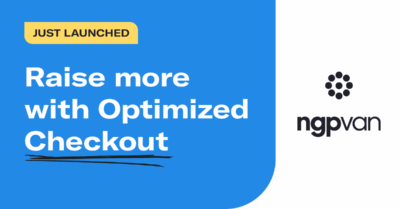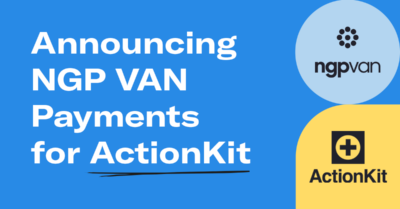Politics and Social Media: How to Create a Winning Strategy

After President Obama’s first intrepid journey into using social media for his presidential campaign in 2008, political campaigns quickly noticed the potential for how social media could help grow their supporter base, mobilize voters, raise awareness, fundraise, and more. However, as social media evolved, the algorithms driving these platforms forward changed too, and the relationship between politics and social media became more complex and regulated. Plus, many platforms monetized their feeds to generate additional revenue, making it harder for organic content to stand out against promoted content. Not to mention that there are a number of stringent regulations related to how you can use social media for political campaigns.
However, with dedicated social media strategies, you can help your political campaign start ranking higher in social media algorithms, expand your reach, and advance toward your goals.
Why is Social Media Important for Political Campaigns?
In addition to your campaign website, your social media accounts help build your digital presence for your campaign. Your website and social media accounts may be the first thing people interact with when they want to find out more about you or your campaign.
However, unlike your website, social media accounts can provide a more personable look into your campaign. It’s unlikely that you’ll update your website every day, but you may post to your social media accounts daily to keep your followers engaged. These daily posts can help illustrate more of the day-to-day activities of your campaign, showcase your campaign’s momentum, and inspire others to get involved. You can also help develop an online community of advocates who engage with your campaign, take action, and donate by using social media for political campaigns. But, to do that, you need to create and execute effective strategies to help advance toward your campaign’s social media goals.
6 Tips for Creating an Effective Political Campaign Social Media Strategy
An effective social media strategy is defined by goals, executed on the right platforms with compelling content, monitored and analyzed regularly, and optimized for the future. With these six tips, you’ll learn how to effectively use social media for political campaigns.
1. Define Your Goals
Before you start posting to social media, it’s important to clearly define your goals so you can measure your success. Some goals may include gaining followers, increasing impressions by a certain percentage, or driving donations from your social media posts. It’s usually a good idea to create SMART (Specific, Measurable, Achievable, Relevant, and Time-Bound) goals so you can have something to aim towards as you scale up your social media game.
You’ll also need to consider your target audience when defining your goals. Are there specific groups of voters or supporters you’re hoping to reach on social media? If so, where do those individuals spend their time on social media? And what types of content do they interact with most? By tailoring your goals to the specific interests and needs of your target audience, you’ll have a better chance of creating engaging content to gain support and increase your reach on social media. After defining your goals and target audiences, you’ll need to choose the social media platforms you want to use for your campaign.
2. Choose the Right Social Media Platforms
Some campaigns rush to start as many social media profiles as possible at the beginning of the election cycle. Unless you have a dedicated social media manager or team of volunteers to help create posts, respond to comments, and more, it will be difficult to monitor all those accounts and keep them updated. It’s typically best to have a few active accounts rather than many sporadically active accounts as the latter can reflect poorly on your campaign. Before you make your decision about which platforms to use, research and identify where your target audience is most active online. In 2021, Pew Research Center captured the data shown in the table below to demonstrate the different demographics of users across various social media platforms. This demographic data can help you understand what platforms may be best to use to engage with your target audience.
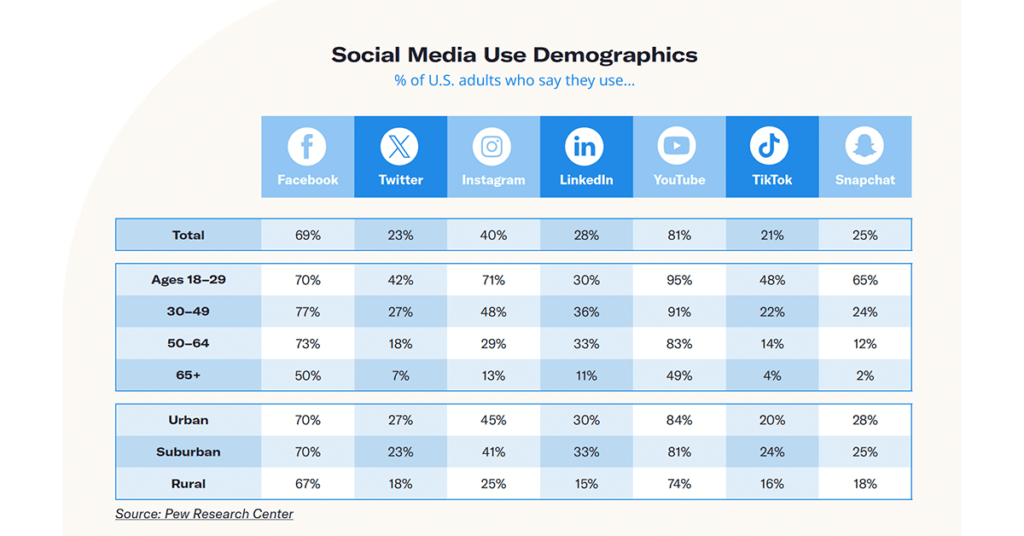
You’ll also need to consider what types of content you plan to capture and which platforms you’re most likely to use. For example, if you’ve never used TikTok and you don’t plan on capturing a lot of video content, it probably doesn’t make sense for you to create an account on that platform. But, if you personally use Facebook often and you are going to capture a variety of content (photos, videos, etc.), starting a campaign-specific account likely makes sense. As social media platforms continue to rise and fall, it may also benefit your campaign to consider using emerging platforms that cater to specific demographics or interests if you can keep your accounts updated. After you decide on the platforms you’re going to use, it’s time to start developing engaging content to share across your accounts!
3. Develop Compelling Content
Compelling content encourages people to take action. It inspires people to sign up to get involved, react to or share content, or interact in some other way. As you begin developing content, make sure to align your content with your campaign’s message and goals. You’ll also want to test different types of content to see what generates the most engagement with your following. Between text-only posts, photos, videos, GIFs, infographics, and more, you can create a varied content cadence that helps you test your content and optimize it for the future.
If you’re looking for some ideas for posts, here are a few examples:
- Post campaign updates: Your followers are interested in your campaign, so share updates when you can. Whether you hit a fundraising goal, qualified for a debate, or anything else, share that news with your followers through a fun video, GIF, or graphic!
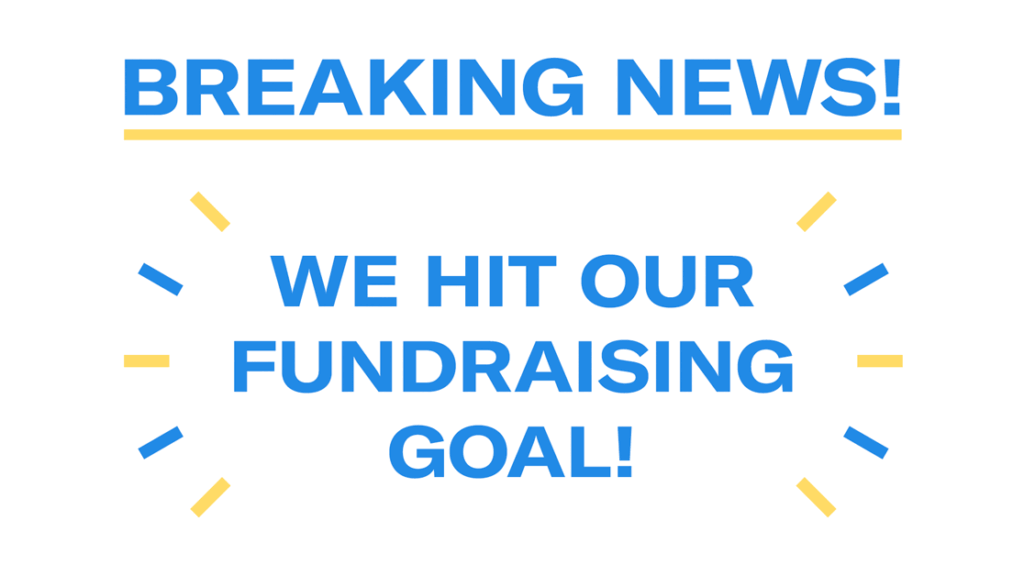
- Discuss where you stand on the issues: Explaining your stances on relevant issues can be one of the best ways to encourage your followers to get involved or donate to your campaign. You could share a simple sentence or statement about your stance in a graphic, then elaborate further on the topic in your post copy. Or you could share a simple video speaking about why you support a specific position on an issue.
- Share behind-the-scenes glimpses of your campaign: Your followers may not know everything that happens on a campaign (especially the late nights and long hours raising money, knocking doors, and more). It can be helpful to show all of the ways you’re working to win, and it will hopefully encourage others to help out! Take a quick selfie during call time or before you launch your canvass to show your work and encourage others to join!
- Highlight important dates: By drawing attention to important dates (like voter registration deadlines, early voting times, and more), you can inform your supporters and reinforce the need to take timely action to support your campaign. For instance, you could highlight National Voter Registration Day and encourage your supporters to register to vote or check their registration to make sure everything is up to date!
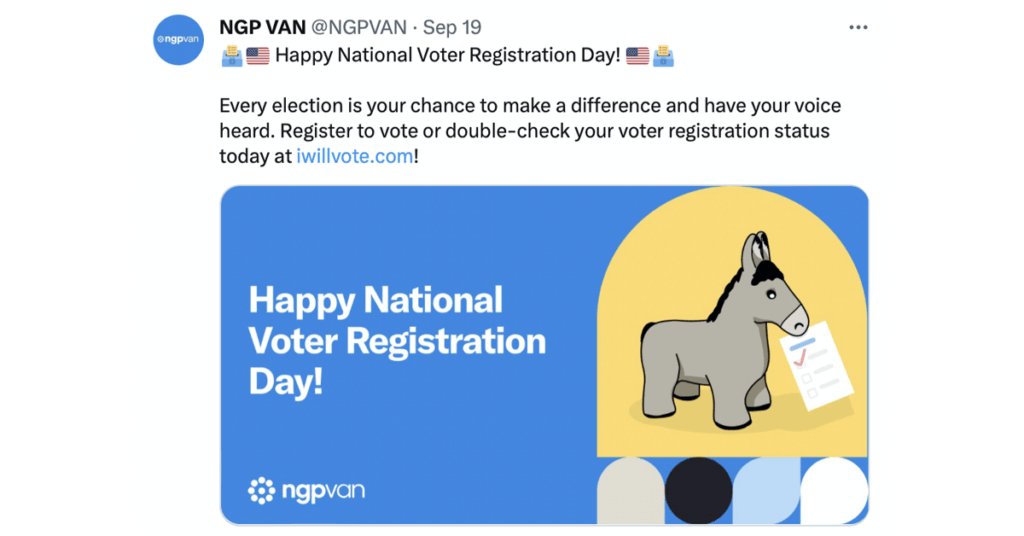
- Engage in storytelling: Storytelling can be a powerful tool to interact with your followers. These types of posts can sometimes stand apart from the rest as they tend to strike a more sincere and personal tone than your day-to-day posts. A storytelling post could explain why you chose to run for office or maybe who inspired you to get involved in your community.
- Ask for donations: By sharing a link to your donation form, you present the opportunity for your followers to contribute to your campaign’s success. Share what contributions will be used for to help connect donors to their impact on your campaign.
- Make infographics: Infographics can help you reinforce or add to the message you’re sharing in your post. For example, maybe your opponent only had 10 donors this quarter, but you had hundreds – put that in a simple bar graph and share it to show your grassroots support!
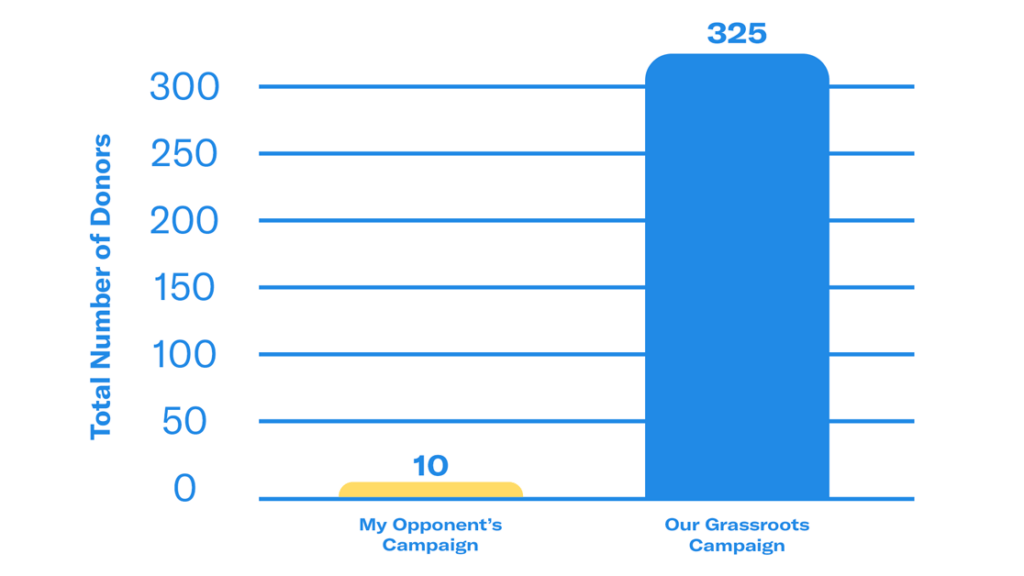
- Consider going live to interact with your followers: Think about going live with your supporters to answer their questions in an online town hall or question-and-answer session. Live-streaming doesn’t allow second takes, so make sure you think through the risks associated with going live too!
- Share links from your website: Encourage your followers to visit your website to read your latest blog on current events, sign up to volunteer, read more about your campaign, and donate. Driving traffic to your website from your social media channels will hopefully help followers take the next step in their supporter journey with your campaign.
If you need some more inspiration, do some research on your favorite social media platforms to stay up-to-date with what’s going on in the political world, and consider if you want to comment on it. Additionally, you could look to some other political influencers, elected officials, or candidates to help inspire your future content too.
While there are numerous content types, messages, and more that you can use to develop your social media strategy, focus on creating quality, compelling content that resonates with your followers and encourages them to interact with it to help boost your social media metrics.
4. Engage with Your Audience
Once your campaign begins posting to social media, you’re going to start seeing comments, messages, and mentions pop up. These engagements are prime opportunities for you to respond to expand your digital reach and presence. You can also encourage interactions by asking questions, conducting polls, and responding to others on their social media posts that mention your campaign.
In addition to engaging your followers online, highlight some of your volunteers and supporters to acknowledge their contributions to your campaign on your social media channels. Whether they donate $5 a month or knock doors with you a few times a week, your supporters power your campaign and it can be helpful to share their stories and contributions to help motivate others to take action.
5. Leverage Endorsements & Consider Paying Influencers
Within your district, you should identify community leaders, elected officials, and other candidates who may endorse your campaign. If they do, their endorsements may include shared press releases, joint fundraising events, financial contributions, or social media posts announcing their endorsement of your campaign. You can easily share those endorsements on social media either from those individuals or you can create your own and ask them to share it on their social media accounts. These endorsements can generate buzz about your campaign, so it’s a great idea to share them on social media when you can!
Paid influencer marketing has also made its way into the political space. There are some companies that specialize in connecting campaigns and causes to political social media influencers to generate more impressions, engagements, and impact. As you develop your social media strategy for your campaign, you may want to consider paid influencer marketing as a valuable engagement tool for your campaign in addition to your organic social media strategy. If you want to learn more about how influencer marketing has made its way into the world of politics, social media, and contributing to impressive online results for political campaigns and causes, check out our webinar with below:
6. Monitor, Analyze, and Adjust
Regularly monitoring the performance of your social media strategy is incredibly important. Most social media platforms provide in-platform analytics tools that can help you analyze metrics to identify what content and tactics are most effective to help achieve your goals. Continue executing what’s going well as you continue to test and optimize other types of content. If you realize that your strategy is not working, shift it accordingly to help increase engagement, reach, and impact.
Launch Your Political Campaign Social Media Strategy
Now that you’ve taken the steps to plan your social media strategy, it’s time to execute it! As you continue to create content to share on social media, make sure to continue testing and optimizing it to further your social media success. Effectively harnessing social media for political campaigns can help raise money, mobilize supporters, and more to help win elections across the country. By following the steps we discussed in this blog, you’ll blend politics and social media to start your campaign on the right track to achieve your goals.
P.S. If you’re planning on using a paid social media strategy, learn more about our social network integration to help turn your social media influence into action.


